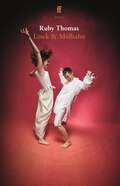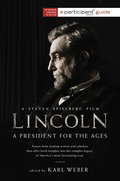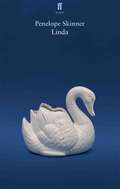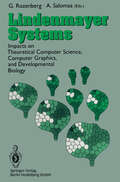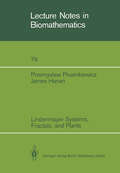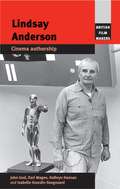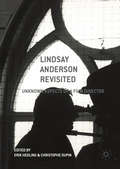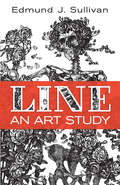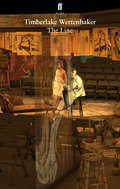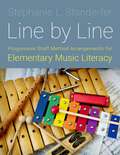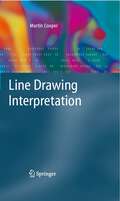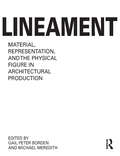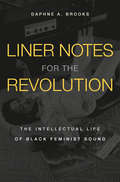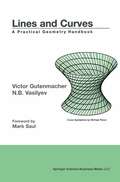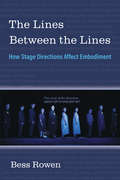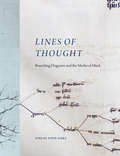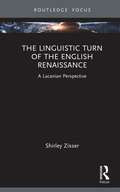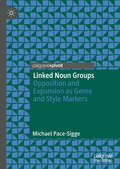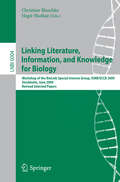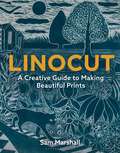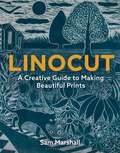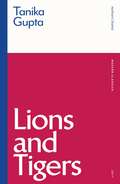- Table View
- List View
Linck & Mülhahn
by Ruby ThomasIt is life's great aim. To find a way to be honest with oneself, even as the world pretends around you.Dashing soldier Anastasius Linck has no intention of falling in love, but a chance encounter with the rebellious Catharina Mülhahn changes everything. As they begin to forge a relationship that breaks boundaries and rejects the rigid rules of their society, they find themselves confronted by a world determined to tear them apart.Ruby Thomas' epic and playful love story, inspired by eighteenth-century court records and the extraordinary lives of a gender-pioneering couple, opened at Hampstead Theatre, London, in January 2023.
Lincoln: A President for the Ages (A\participant Media Guide Ser.)
by Participant MediaThe First American. Frontiersman and backwoods attorney. Teller of bawdy tales and a spellbinding orator. A champion of liberty some called a would-be tyrant. Savior of the Union and the Great Emancipator. All these are Abraham Lincoln-in his time America's most admired and reviled leader, and still our nation's most enigmatic and captivating hero.Timed to complement the new motion picture Lincoln, directed by Steven Spielberg, Lincoln: A President for the Ages introduces a new Lincoln grappling with some of history's greatest challenges. Would Lincoln have dropped the bomb on Hiroshima? How would he conduct the War on Terror? Would he favor women's suffrage or gay rights? Would today's Lincoln be a star on Facebook and Twitter? Would he embrace the religious right-or denounce it?The answers come from an all-star array of historians and scholars, including Jean Baker, Richard Carwardine, Dan Farber, Andrew Ferguson, Henry Louis Gates Jr., Allen C. Guelzo, Harold Holzer, James Malanowski, James Tackach, Frank J. Williams, and Douglas L. Wilson. Lincoln also features actor/activist Gloria Reuben describing how she played Elizabeth Keckley, the former-slave-turned-confidante of First Lady Mary Todd Lincoln; and a selection of speeches and letters that explore little-known sides of Lincoln; "The Faces of Lincoln,” exploring his complex contemporary legacy.Whether you're a lifetime admirer of Lincoln or newly intrigued by his story, Lincoln: A President for the Ages offers a fascinating glimpse of his many-sided legacy.
Linda
by Penelope SkinnerI'm an award-winning business woman. I'm happily married with two beautiful daughters and I still fit in the same size-ten dress suit I did fifteen years ago. What could possibly threaten me?Linda Wilde has dedicated her life to changing the world. She's won awards for her efforts, at the same time as working hard to become an inspiring mother, and an independent, loving wife.Now, at 55, she seems to have it all. She's a woman in her prime. She's embarking on her most ambitious plan to date. Beneath the surface, though, the cracks are starting to show.Linda by Penelope Skinner premiered at the Royal Court Theatre, London, in November 2015.
Lindenmayer Systems: Impacts on Theoretical Computer Science, Computer Graphics, and Developmental Biology
by Grzegorz Rozenberg Arto SalomaaL systems are language-theoretic models for developmental biology. They wereintroduced in 1968 by Aristid Lindenmayer (1925-1989) and have proved to be among the most beautiful examples of interdisciplinary science, where work in one area induces fruitful ideas and results in other areas. L systemsare based on relational and set-theoretic concepts, which are more suitable for the discrete and combinatorial structures of biology than mathematical models based on calculus or statistics. L systems have stimulated new work not only in the realistic simulation of developing organisms but also in the theory of automata and formal languages, formal power series, computer graphics, and combinatorics of words. This book contains research papers by almost all leading authorities and by many of the most promising young researchers in the field. The 28 contributions are organized in sections on basic L systems, computer graphics, graph grammars and map L systems, biological aspects and models, and variations and generalizations of L systems. The introductory paper by Lindenmayer and J}rgensen was written for a wide audience and is accessible to the non-specialist reader. The volume documents the state of the art in the theory of L systems and their applications. It will interest researchers and advanced students in theoretical computer science and developmental biology as well as professionals in computer graphics.
Lindenmayer Systems, Fractals, and Plants (Lecture Notes in Biomathematics #79)
by Przemyslaw Prusinkiewicz James Hanan1-systems are a mathematical formalism which was proposed by Aristid 1indenmayer in 1968 as a foundation for an axiomatic theory of develop ment. The notion promptly attracted the attention of computer scientists, who investigated 1-systems from the viewpoint of formal language theory. This theoretical line of research was pursued very actively in the seventies, resulting in over one thousand publications. A different research direction was taken in 1984 by Alvy Ray Smith, who proposed 1-systems as a tool for synthesizing realistic images of plants and pointed out the relationship between 1-systems and the concept of fractals introduced by Benoit Mandel brot. The work by Smith inspired our studies of the application of 1-systems to computer graphics. Originally, we were interested in two problems: • Can 1-systems be used as a realistic model of plant species found in nature? • Can 1-systems be applied to generate images of a wide class of fractals? It turned out that both questions had affirmative answers. Subsequently we found that 1-systems could be applied to other areas, such as the generation of tilings, reproduction of a geometric art form from East India, and synthesis of musical scores based on an interpretation of fractals. This book collects our results related to the graphical applications of- systems. It is a corrected version of the notes which we prepared for the ACM SIGGRAPH '88 course on fractals.
Lindsay Anderson: Cinema authorship (British Film-Makers)
by John Izod Karl Magee Kathryn Hannan Isabelle Gourdin-SangouardIn a long and varied career, Lindsay Anderson made training films, documentaries, searing family dramas and blistering satires, including This Sporting Life, O Lucky Man! and Britannia Hospital. Students of British cinema and television from the 1950s to 1990s will find this book a valuable source of information about a director whose work came to public attention with Free Cinema but who, unlike many of his peers in that movement did not take the Hollywood route to success. What emerges is a strong feeling for the character of the man as well as for a remarkable career in British cinema. The book will appeal to admirers, researchers and students alike. Making use of hitherto unseen original materials from Anderson’s extensive personal and professional records, it is most valuable as a study of how the films came about: the production problems involved, the collaborative input of others, as well as the completed films’ promotion and reception. It also offers a finely argued take on the whole issue of film authorship, and achieves the rare feat of being academically authoritative whilst also being completely accessible. It prompts renewed respect for the man and the artist and a desire to watch the films all over again.
Lindsay Anderson Revisited: Unknown Aspects of a Film Director
by Erik Hedling Christophe DupinThis book is about the British film-maker Lindsay Anderson. Anderson was a highly influential personality within British cinema, mostly famous for landmark films like This Sporting Life (1963) and If….(1968). Lindsay Anderson Revisited deals primarily with hitherto unexplored aspects of his career: his biographical background in the British upper class, his devoted film criticism, and his angry relationship to contemporary society in general. Thus, the book contains chapters about his childhood in India, his writings about John Ford, his relationship to French star Serge Reggiani, his work on TV in the 1950s, his troubles with the British film establishment, and his gradually emerging preoccupation with being Scottish, not English. Also featured are chapters written by close friends of Anderson, who died in 1994, dwelling on his penchant for controversy and quarrel, but also on his remarkable artistic talent and commitment.
Line: An Art Study
by Edmund J. SullivanWritten by a noted illustrator and teacher, this guide introduces the basics of line drawing. British artist Edmund J. Sullivan, who merges the traditional nineteenth-century style of illustration with elements of Art Nouveau, begins by introducing readers to the freehand drawing of abstract lines and advances to the freehand drawing of natural forms, consisting mainly of plane surfaces or single lines.Subsequent chapters illustrate and discuss representations of the third and fourth dimensions, the picture plane, formal perspective, and the drawing of solid objects, including their depiction in shade and shadow, and their modelling. Additional topics include shadows, reflections, and aerial perspective as well as figure drawing.
The Line
by Timberlake WertenbakerHow did you learn to draw a line that is so ferocious and so supple? There is no question Mademoiselle . . .You are one of us.From unexpected quarters in nineteenth century France, a bright new talent emerges: confident, penniless, and a woman. But circumstance is no obstacle to Suzanne Valadon. For the great Edgar Degas, his ambitious protégée proves the biggest challenge of his life.Timberlake Wertenbaker's The Line premiered at the Arcola Theatre, London, in November 2009.
Line by Line: Progressive Staff Method Arrangements for Elementary Music Literacy
by Stephanie L. StanderferIn Line by Line, author Stephanie L. Standerfer harnesses years of pedagogical expertise in a practical guide to promote music learning by experience rather than imitation and memorization. Using well-known songs and a variety of instrumental accompaniments for all skill levels, lesson plans encourage students to first learn music conceptually by internalizing the sound and feeling before learning musical symbols. The lesson plans are tailored for five to seven spiraled class periods and take every student into consideration by suggesting ways to address specific student needs for those who need more time to process.
LINE BY LINE C: Progressive Staff Method Arrangements for Elementary Music Literacy
by Stephanie L. StanderferIn Line by Line, author Stephanie L. Standerfer harnesses years of pedagogical expertise in a practical guide to promote music learning by experience rather than imitation and memorization. Using well-known songs and a variety of instrumental accompaniments for all skill levels, lesson plans encourage students to first learn music conceptually by internalizing the sound and feeling before learning musical symbols. The lesson plans are tailored for five to seven spiraled class periods and take every student into consideration by suggesting ways to address specific student needs for those who need more time to process.
Lineament: Material, Representation and the Physical Figure in Architectural Production
by Gail Peter Borden Michael MeredithThis comprehensive catalogue of contemporary work examines the renewed investment in the relationship between representation, materiality, and architecture. It assembles a range of diverse voices across various institutions, practices, generations, and geographies, through specific case studies that collectively present a broader theoretical intention.
Lineament: Material, Representation and the Physical Figure in Architectural Production
by Gail Peter Borden and Michael MeredithThis comprehensive catalogue of contemporary work examines the renewed investment in the relationship between representation, materiality, and architecture. It assembles a range of diverse voices across various institutions, practices, generations, and geographies, through specific case studies that collectively present a broader theoretical intention.
Liner Notes for the Revolution: The Intellectual Life of Black Feminist Sound
by Daphne A. BrooksAn award-winning Black feminist music critic takes us on an epic journey through radical sound from Bessie Smith to Beyoncé. Daphne A. Brooks explores more than a century of music archives to examine the critics, collectors, and listeners who have determined perceptions of Black women on stage and in the recording studio. How is it possible, she asks, that iconic artists such as Aretha Franklin and Beyoncé exist simultaneously at the center and on the fringe of the culture industry? Liner Notes for the Revolution offers a startling new perspective on these acclaimed figures—a perspective informed by the overlooked contributions of other Black women concerned with the work of their musical peers. Zora Neale Hurston appears as a sound archivist and a performer, Lorraine Hansberry as a queer Black feminist critic of modern culture, and Pauline Hopkins as America’s first Black female cultural commentator. Brooks tackles the complicated racial politics of blues music recording, song collecting, and rock and roll criticism. She makes lyrical forays into the blues pioneers Bessie Smith and Mamie Smith, as well as fans who became critics, like the record-label entrepreneur and writer Rosetta Reitz. In the twenty-first century, pop superstar Janelle Monae’s liner notes are recognized for their innovations, while celebrated singers Cécile McLorin Salvant, Rhiannon Giddens, and Valerie June take their place as cultural historians. With an innovative perspective on the story of Black women in popular music—and who should rightly tell it—Liner Notes for the Revolution pioneers a long overdue recognition and celebration of Black women musicians as radical intellectuals.
Lines and Curves: A Practical Geometry Handbook
by Victor Gutenmacher N.B. VasilyevBroad appeal to undergraduate teachers, students, and engineers; Concise descriptions of properties of basic planar curves from different perspectives; useful handbook for software engineers; A special chapter---"Geometry on the Web"---will further enhance the usefulness of this book as an informal tutorial resource.; Good mathematical notation, descriptions of properties of lines and curves, and the illustration of geometric concepts facilitate the design of computer graphics tools and computer animation.; Video game designers, for example, will find a clear discussion and illustration of hard-to-understand trajectory design concepts.; Good supplementary text for geometry courses at the undergraduate and advanced high school levels
The Lines Between the Lines: How Stage Directions Affect Embodiment
by Bess RowenWhat is the purpose of a stage direction? These italicized lines written in between the lines of spoken dialogue tell us a great deal of information about a play's genre, mood, tone, visual setting, cast of characters, and more. Yet generations of actors have been taught to cross these words out as records of previous performances or signs of overly controlling playwrights, while scholars have either treated them as problems to be solved or as silent lines of dialogue. Stage directions can be all of these things, and yet there are examples from over one-hundred years of American playwriting that show that stage directions can also be so much more. The Lines Between the Lines focuses on how playwrights have written stage directions that engage readers, production team members, and scholars in a process of embodied creation in order to determine meaning. Author Bess Rowen calls the products of this method “affective stage directions” because they reach out from the page and affect the bodies of those who encounter them. Affective stage directions do not tell a reader or production team what a given moment looks like, but rather how a moment feels. In this way, these stage directions provide playgrounds for individual readers or production teams to make sense of a given moment in a play based on their own individual cultural experience, geographic location, and identity-markers. Affective stage directions enable us to check our assumptions about what kinds of bodies are represented on stage, allowing for a greater multitude of voices and kinds of embodied identity to make their own interpretations of a play while still following the text exactly. The tools provided in this book are as useful for the theater scholar as they are for the theater audience member, casting director, and actor. Each chapter covers a different function of stage directions (spoken, affective, choreographic, multivalent, impossible) and looks at it through a different practical lens (focusing on actors, directors, designers, dramaturgs, and readers). Every embodied person will have a slightly different understanding of affective stage directions, and it is precisely this diversity that makes these stage directions crucial to understanding theater in our time.
Lines of Thought: Branching Diagrams and the Medieval Mind
by Ayelet Even-EzraWe think with objects—we conduct our lives surrounded by external devices that help us recall information, calculate, plan, design, make decisions, articulate ideas, and organize the chaos that fills our heads. Medieval scholars learned to think with their pages in a peculiar way: drawing hundreds of tree diagrams. Lines of Thought is the first book to investigate this prevalent but poorly studied notational habit, analyzing the practice from linguistic and cognitive perspectives and studying its application across theology, philosophy, law, and medicine. These diagrams not only allow a glimpse into the thinking practices of the past but also constitute a chapter in the history of how people learned to rely on external devices—from stone to parchment to slide rules to smartphones—for recording, storing, and processing information. Beautifully illustrated throughout with previously unstudied and unedited diagrams, Lines of Thought is a historical overview of an important cognitive habit, providing a new window into the world of medieval scholars and their patterns of thinking.
The Linguistic Turn of the English Renaissance: A Lacanian Perspective (Routledge Focus on Mental Health)
by Shirley ZisserThe Linguistic Turn of the English Renaissance: A Lacanian Perspective examines a selection of cultural phenomena of the English Renaissance, all of which include a focus on language, from a Lacanian perspective. The book examines four inter-related cultural symptoms of the English Renaissance: the paucity of painting, the interest in rhetoric, the emergence of a literary style focusing on form and a fascination with the myth of Orpheus. The book argues that the English Renaissance, an apex of rhetorical theory, can offer psychoanalysis further knowledge concerning the intrication of language and flesh, especially where feminine jouissance is at stake. These language-centred phenomena emerge against the backdrop of a peculiar configuration of the visual field, which in contrast to other cultures of the European Renaissance is largely barren of painting other than portraiture. The book will be of interest to psychoanalysts, scholars of Renaissance culture and those interested in the psychoanalytic study of culture.
The Linguistic Turn of the English Renaissance: A Lacanian Perspective (Routledge Focus on Mental Health)
by Shirley ZisserThe Linguistic Turn of the English Renaissance: A Lacanian Perspective examines a selection of cultural phenomena of the English Renaissance, all of which include a focus on language, from a Lacanian perspective. The book examines four inter-related cultural symptoms of the English Renaissance: the paucity of painting, the interest in rhetoric, the emergence of a literary style focusing on form and a fascination with the myth of Orpheus. The book argues that the English Renaissance, an apex of rhetorical theory, can offer psychoanalysis further knowledge concerning the intrication of language and flesh, especially where feminine jouissance is at stake. These language-centred phenomena emerge against the backdrop of a peculiar configuration of the visual field, which in contrast to other cultures of the European Renaissance is largely barren of painting other than portraiture. The book will be of interest to psychoanalysts, scholars of Renaissance culture and those interested in the psychoanalytic study of culture.
Linked Noun Groups: Opposition and Expansion as Genre and Style Markers
by Michael Pace-SiggeThis book provides a corpus-led analysis of multi-word units (MWUs) in English, specifically fixed pairs of nouns which are linked by a conjunction, such as 'mum and dad', 'bride and groom' and 'law and order'. Crucially, the occurrence pattern of such pairs is dependent on genre, and this book aims to document the structural distribution of some key Linked Noun Groups (LNGs). The author looks at the usage patterns found in a range of poetry and fiction dating from the 17th to 20th century, and also highlights the important role such binomials play in academic English, while acknowledging that they are far less common in casual spoken English. His findings will be highly relevant to students and scholars working in language teaching, stylistics, and language technology (including AI).
Linking, Literature, Information, and Knowledge for Biologie: Workshop of the BioLINK Special Interest Group, ISBM/ECCB 2009, Stockholm, June 28-29, 2009, Revised Selected Papers (Lecture Notes in Computer Science #6004)
by Hagit Shatkay Christian BlaschkeLinocut: A Creative Guide to Making Beautiful Prints
by Sam MarshallA step-by-step guide on how to create personal and contemporary linocut prints.A linocut is a relief print created by carving a design into a printing block. It is the uncut surface, not the carved away areas, that gives you your image when you roll it with ink, lay paper on top then apply pressure to produce a print. With 18 easy-to-follow projects that can be adapted to suit your own ideas, experienced printmaker Sam Marshall guides you through the whole process – from the drawing to the carving to the inking to the printing – of creating your own beautiful prints and handmade cards whether you are working from your kitchen table or a more advanced studio set-up. By taking inspiration from everyday life, Sam helps you to build your confidence with observational drawing. Featuring step-by-step projects, the book demonstrates a range of skills with low-cost materials to produce simple linocuts, reduction linocuts and colourful multi-block prints. You will also learn more experimental techniques such as combining monoprint, chine collé, jigsaw linocuts and rainbow rolls and pick up handy tips on subjects such as 'noise' and editioning your prints. Beautifully illustrated with photographs of Sam's own drawings and linocuts, and featuring the work of 5 talented printmakers, Linocut is an essential guide to linocut printmaking. Packed with creative and practical advice to guide and encourage you, whether you're just starting out, returning to the craft or looking to expand your printmaking skills.
Linocut: A Creative Guide to Making Beautiful Prints
by Sam MarshallA step-by-step guide on how to create personal and contemporary linocut prints.A linocut is a relief print created by carving a design into a printing block. It is the uncut surface, not the carved away areas, that gives you your image when you roll it with ink, lay paper on top then apply pressure to produce a print. With 18 easy-to-follow projects that can be adapted to suit your own ideas, experienced printmaker Sam Marshall guides you through the whole process – from the drawing to the carving to the inking to the printing – of creating your own beautiful prints and handmade cards whether you are working from your kitchen table or a more advanced studio set-up. By taking inspiration from everyday life, Sam helps you to build your confidence with observational drawing. Featuring step-by-step projects, the book demonstrates a range of skills with low-cost materials to produce simple linocuts, reduction linocuts and colourful multi-block prints. You will also learn more experimental techniques such as combining monoprint, chine collé, jigsaw linocuts and rainbow rolls and pick up handy tips on subjects such as 'noise' and editioning your prints. Beautifully illustrated with photographs of Sam's own drawings and linocuts, and featuring the work of 5 talented printmakers, Linocut is an essential guide to linocut printmaking. Packed with creative and practical advice to guide and encourage you, whether you're just starting out, returning to the craft or looking to expand your printmaking skills.
Lions and Tigers (Modern Classics)
by Tanika Gupta"Tanika Gupta's epic drama pushes the boundaries of verbatim theatre, telling an important story in a fresh and authentic way never seen on stage before. A rousing piece of work." - Greg Walker, Regius Professor of Rhetoric and English Literature, University of Edinburgh, UK. Based on the true story of Tanika Gupta's great uncle, Lions and Tigers follows nineteen-year-old Dinesh Gupta's emotional and political awakening as a freedom fighter pitting himself against the British Raj.Drawn from family stories that the playwright herself heard from early childhood, the play teems with details drawn from her grandfather's 500-page handwritten journal about his younger brother, and from the 92 letters written by her great uncle from his prison cell.Set against the backdrop of negotiations between the leaders of the Indian National Congress and culminating in actions that shook the very foundations of the British Empire, Lions and Tigers challenges our assumptions about Indian independence and offers powerful new insights into the battles between the British lions and the Bengal tigers. The play was first performed at Shakespeare's Globe from the 23rd August to 16th September 2017, and was awarded the James Tait Black Prize for Drama in 2018. It is published here in Methuen Drama's Modern Classics series for the first time, with a brand new introduction.
